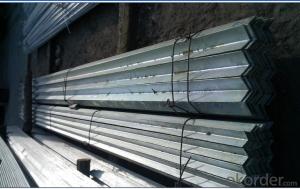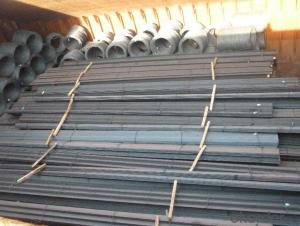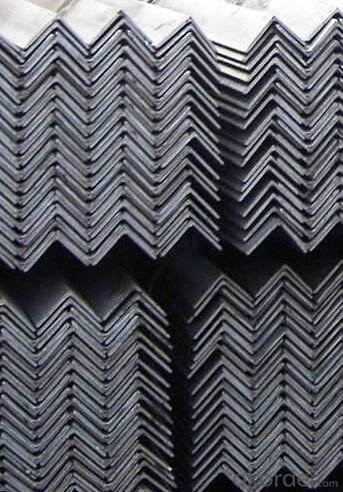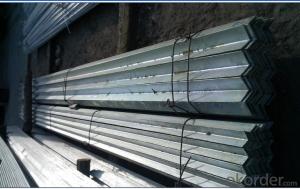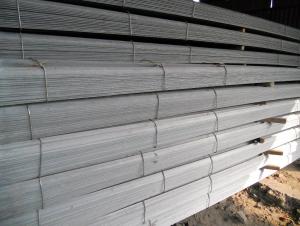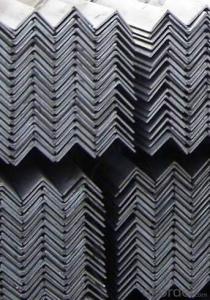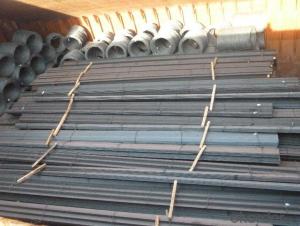GB STANDARD HIGH QUALITY HOT ROLLED ANGLE
- Loading Port:
- Tianjin
- Payment Terms:
- TT OR LC
- Min Order Qty:
- 50 m.t.
- Supply Capability:
- 100000 m.t./month
OKorder Service Pledge
OKorder Financial Service
You Might Also Like
Appearance: Black
Technique: Slitting hot rolled steel coil
Grade: Q235, Q195,A36 SS400 S235jr.St37-2
Standard: AISI,GB,DIN,ASTM,EN,JIS
Length: 6m, 9m, 12m or as your requirement.
Width: 10mm-1010mm
Thickness: 1.5mm-20mm
Business type: big manufacture
Place of origin: Tianjin China (Mainland)
Packaging Details: In bundles for exporting and sea worthy
Delivery Detail: Within 15-35 days after receiving L/C or deposite T/T

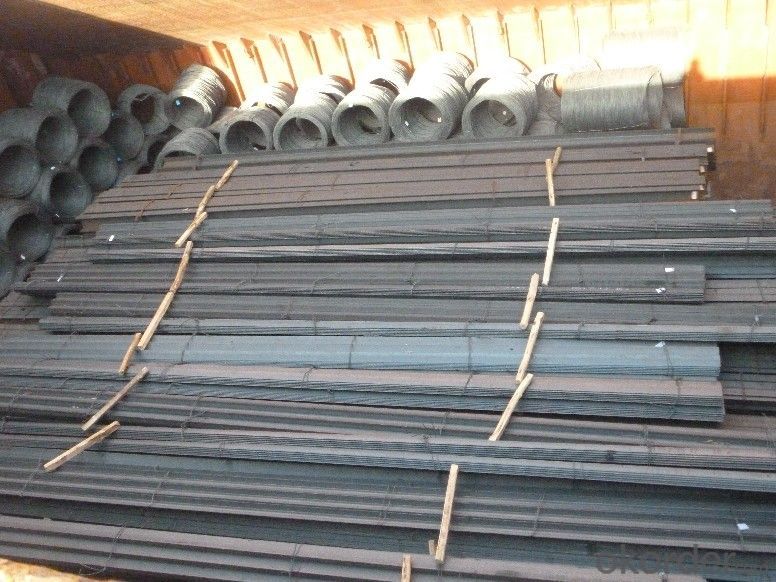
General specification as below:
Flat Bar Specification | |||
Width (mm) | Thickness (mm) | Length (m) | Theoretical Weight (kg/m) |
20 | 2.0 | 6/9/12 | 0.31 |
20 | 2.5 | 6/9/12 | 0.39 |
20 | 2.75 | 6/9/12 | 0.43 |
25 | 2.5 | 6/9/12 | 0.49 |
25 | 3.75 | 6/9/12 | 0.74 |
30 | 2.5 | 6/9/12 | 0.59 |
30 | 3.5 | 6/9/12 | 0.82 |
30 | 9.75 | 6/9/12 | 2.30 |
40 | 3.5 | 6/9/12 | 1.10 |
40 | 4.75 | 6/9/12 | 1.50 |
40 | 11.75 | 6/9/12 | 3.69 |
50 | 2.75 | 6/9/12 | 1.08 |
50 | 4.5 | 6/9/12 | 1.77 |
50 | 9.75 | 6/9/12 | 3.83 |
60 | 5.5 | 6/9/12 | 2.60 |
60 | 7.5 | 6/9/12 | 3.53 |
60 | 11.5 | 6/9/12 | 5.42 |
80 | 5.5 | 6/9/12 | 3.45 |
80 | 7.5 | 6/9/12 | 4.71 |
80 | 11.75 | 6/9/12 | 7.38 |
100 | 3.25 | 6/9/12 | 2.55 |
100 | 4.75 | 6/9/12 | 3.73 |
100 | 7.5 | 6/9/12 | 5.89 |
120 | 9.75 | 6/9/12 | 9.18 |
120 | 11.75 | 6/9/12 | 11.07 |
150 | 9.75 | 6/9/12 | 11.48 |
150 | 11.5 | 6/9/12 | 13.54 |
150 | 13.5 | 6/9/12 | 15.90 |
160 | 11.75 | 6/9/12 | 14.76 |
200 | 9.5 | 6/9/12 | 14.92 |
250 | 5.75 | 6/9/12 | 11.28 |
340 | 7.75 | 6/9/12 | 20.68 |
Products Advantages
1. high quality competitive price and Accurate in size
2. high dimensional accuracy
3. Guaranteed raw material
4.high utilization rate of material
5.convenient in construction, saving much time and labor
6. high mechanical strength
Application: Widely used for construction, Ship building, Machinery manufacturing ,steel structure,agriculture and steel grating.
- Q: How do you calculate the strength of a steel angle?
- Calculating the strength of a steel angle requires consideration of several factors. Important parameters to take into account include the angle's dimensions, the steel's material properties, and the applied load or force. Firstly, determining the dimensions of the angle is necessary. This entails measuring the lengths of both legs and the angle's thickness. These measurements are crucial for calculating the area moment of inertia, which plays a vital role in determining the angle's strength. Next, knowledge of the steel angle's material properties is essential. This includes information on the yield strength, ultimate tensile strength, and modulus of elasticity. Material specifications or testing can be used to obtain these properties. Once the dimensions and material properties are known, the strength of the steel angle can be calculated using various formulas and equations. One commonly used approach involves calculating the section modulus, which measures the angle's resistance to bending. The section modulus can be determined using the formula Z = (b × h^2)/6, where b represents the angle's thickness and h corresponds to the distance between the centroid of the angle and the outer edge. To determine the strength of the angle, it is necessary to compare the applied load or force with the calculated section modulus. If the applied load falls within the limits of the section modulus, the angle is considered structurally sound. However, if the applied load exceeds the section modulus, there is a risk of failure. It's important to note that the strength calculations for a steel angle are based on assumptions and ideal conditions. Real-world factors such as material imperfections, fabrication processes, and load distribution can affect the actual strength of the angle. Therefore, it is advisable to consult structural engineers or reference design codes to ensure accurate calculations and safe design.
- Q: How do you prevent steel angles from corroding in saltwater environments?
- To prevent steel angles from corroding in saltwater environments, several measures can be taken. One effective way is to apply a protective coating on the steel angles, such as galvanization or painting with corrosion-resistant coatings. These coatings act as a barrier, preventing direct contact between the steel and saltwater. Additionally, regular maintenance and inspection are crucial to identify any signs of corrosion early on and take necessary actions such as cleaning, reapplication of coatings, or replacing the steel angles if required.
- Q: How do steel angles contribute to the overall stability of a building?
- Steel angles are an essential component of the overall stability of a building. They provide structural support and enhance the load-bearing capacity of the building framework. The angle shape of steel angles allows them to efficiently distribute and transfer the loads imposed on the structure, such as the weight of the floors, walls, and the roof, to the foundation. One of the key contributions of steel angles to the stability of a building is their ability to resist bending and buckling forces. The L-shaped design of steel angles helps to prevent the structural members from collapsing or deforming under heavy loads or external pressures. This resistance to bending and buckling ensures that the building remains structurally sound and stable, even in adverse conditions such as earthquakes or strong winds. Furthermore, steel angles are often used as bracing elements to provide lateral stability to the building. They are strategically placed in areas that require reinforcement against horizontal forces, such as wind or seismic activity. By connecting different structural components, steel angles help to distribute these lateral forces throughout the building, preventing excessive movement or deformation and maintaining the overall stability of the structure. In addition to their role in load-bearing and bracing, steel angles also contribute to the overall stability of a building through their durability and resistance to corrosion. Steel angles are typically made from high-strength steel, which offers excellent structural integrity and long-term reliability. This durability ensures that the building can withstand the test of time and remain stable throughout its lifespan. Overall, steel angles play a crucial role in enhancing the overall stability of a building. Their ability to resist bending and buckling forces, provide lateral stability, and their durability make them an integral part of the building's structural system. By effectively distributing and transferring loads, steel angles ensure that the building remains safe, secure, and stable, ensuring the well-being of its occupants and the longevity of the structure.
- Q: What does "L125*8" stand for in steel structures?
- Angle steel is divided into equal angle steel and unequal angle steel. The expression of the equal angle steel model is b*d, in which B is the unilateral width of the equilateral angle steel, and the D is the thickness, and the unit is MM. Unequal angles are named by the ratio of the length to the width of a centimeter and the width of a short edge. Therefore, the L125*8 represents an equilateral angle steel beam with a unilateral width of 125 and a thickness of 8. I hope this problem can be solved for you.
- Q: Can steel angles be galvanized or coated for additional protection?
- Yes, steel angles can indeed be galvanized or coated for additional protection. Galvanizing is a common method used to protect steel from corrosion. It involves coating the steel with a layer of zinc, which acts as a barrier against moisture and other corrosive elements. This process can be done through hot-dip galvanizing, where the steel angle is immersed in a bath of molten zinc, or through electroplating, where a thin layer of zinc is applied to the surface of the steel through an electric current. Coating steel angles with other protective materials is also a viable option. There are various coating options available, such as epoxy, powder coatings, and paint. These coatings create a protective layer on the surface of the steel, shielding it from environmental factors that could lead to corrosion or damage. By galvanizing or coating steel angles, additional protection is provided, extending the lifespan of the material and ensuring its durability in different applications and environments.
- Q: Can steel angles be used in the construction of transmission towers?
- Yes, steel angles can be used in the construction of transmission towers. They are commonly used to provide structural support and stability to the towers, ensuring strength and durability in the transmission infrastructure.
- Q: What are the different welding methods used for steel angles?
- There are several different welding methods that can be used for steel angles. The choice of method depends on various factors including the thickness of the steel, the type of joint, and the desired outcome. Here are some of the commonly used welding methods for steel angles: 1. Shielded Metal Arc Welding (SMAW): Also known as stick welding, SMAW uses a consumable electrode coated in flux. The electrode is manually fed into the joint, and the flux creates a protective shield around the weld pool. SMAW is versatile and can be used for various joint configurations and thicknesses. 2. Gas Metal Arc Welding (GMAW): Commonly referred to as MIG (Metal Inert Gas) or MAG (Metal Active Gas) welding, GMAW uses a wire electrode that is continuously fed through a welding gun. The electrode melts and joins the steel angles together, while a shielding gas (either inert or active) protects the weld pool. GMAW is fast and suitable for thin to medium thickness steel angles. 3. Flux-Cored Arc Welding (FCAW): Similar to GMAW, FCAW uses a continuously fed wire electrode. However, the electrode is filled with flux, eliminating the need for an external shielding gas. FCAW is versatile, easy to use, and can be employed in various positions. It is commonly used for thicker steel angles and in outdoor applications where wind might affect gas shielding. 4. Gas Tungsten Arc Welding (GTAW): Also known as TIG (Tungsten Inert Gas) welding, GTAW uses a non-consumable tungsten electrode to create an arc. A separate filler metal is manually added to the joint, while a shielding gas protects the weld pool. GTAW produces high-quality, precise welds and is commonly used for thinner steel angles or when aesthetics are important. 5. Submerged Arc Welding (SAW): This method involves feeding a continuously fed wire electrode into the joint while simultaneously covering the weld area with a layer of granular flux. The flux acts as a protective medium and prevents atmospheric contamination. SAW is commonly used for thicker steel angles and in applications where high deposition rates are required. These are just a few of the welding methods commonly used for steel angles. Each method has its advantages and limitations, and the choice of method should be based on the specific requirements of the project. It is important to consult with a qualified welding professional to determine the most suitable method for a particular application.
- Q: What are the dimensions of a standard steel angle?
- The specific requirements and standards determine the dimensions of a standard steel angle, which can vary. Generally, it is a structural steel member in an L shape with legs that may be equal or unequal. The standard dimensions usually encompass the overall length, width, and thickness. For instance, one might find a standard steel angle with an overall length of 20 feet, a width of 2 inches, and a thickness of 1/4 inch. Nevertheless, it is crucial to acknowledge that the dimensions may differ depending on the specific application and industry standards.
- Q: What is the process of galvanizing steel angles?
- The process of galvanizing steel angles involves several steps to ensure the steel angles are coated with a layer of zinc for protection against corrosion. Firstly, the steel angles are cleaned to remove any dirt, oil, or rust from the surface. This is typically done through a process called pickling, where the angles are immersed in a solution of acid, usually hydrochloric acid, to remove any impurities. Once the steel angles are cleaned, they are then rinsed to remove any residual acid and dried thoroughly. This is important to ensure proper adhesion of the zinc coating. After the cleaning process, the steel angles are dipped into a bath containing molten zinc. This is done through a process called hot-dip galvanizing, where the angles are fully immersed in the zinc bath. The temperature of the zinc bath is typically around 840°F (449°C). As the steel angles are immersed in the zinc bath, a metallurgical reaction occurs between the steel and the molten zinc. This reaction forms a layer of zinc-iron alloy on the surface of the angles. This layer provides excellent corrosion resistance and acts as a barrier between the steel and the corrosive elements in the environment. After the angles have been fully immersed in the zinc bath, they are then removed and allowed to cool. The cooling process solidifies the zinc coating and ensures its adhesion to the steel angles. Finally, the galvanized steel angles are inspected for quality control. This includes checking the coating thickness, uniformity, and adherence to the angles. Various tests and measurements are performed to ensure that the galvanized coating meets the required standards and specifications. Overall, the process of galvanizing steel angles involves cleaning, immersion in a molten zinc bath, cooling, and inspection. This process provides a durable and long-lasting protective coating on the steel angles, making them resistant to corrosion and extending their lifespan.
- Q: Can steel angles be used in shelving systems?
- Yes, steel angles can be used in shelving systems. Steel angles provide excellent structural support and stability, making them a popular choice for shelving units. They can be easily attached to walls or used as vertical supports, allowing for the customization of shelving layouts. Additionally, steel angles are durable and capable of holding heavy loads, making them suitable for various storage needs.
Send your message to us
GB STANDARD HIGH QUALITY HOT ROLLED ANGLE
- Loading Port:
- Tianjin
- Payment Terms:
- TT OR LC
- Min Order Qty:
- 50 m.t.
- Supply Capability:
- 100000 m.t./month
OKorder Service Pledge
OKorder Financial Service
Similar products
Hot products
Hot Searches
Related keywords
